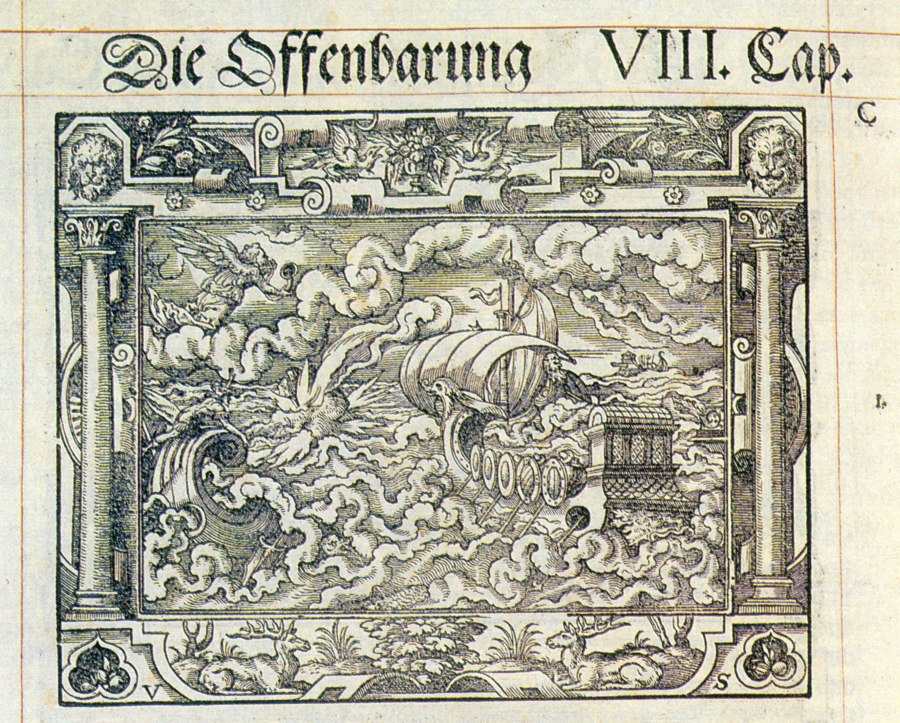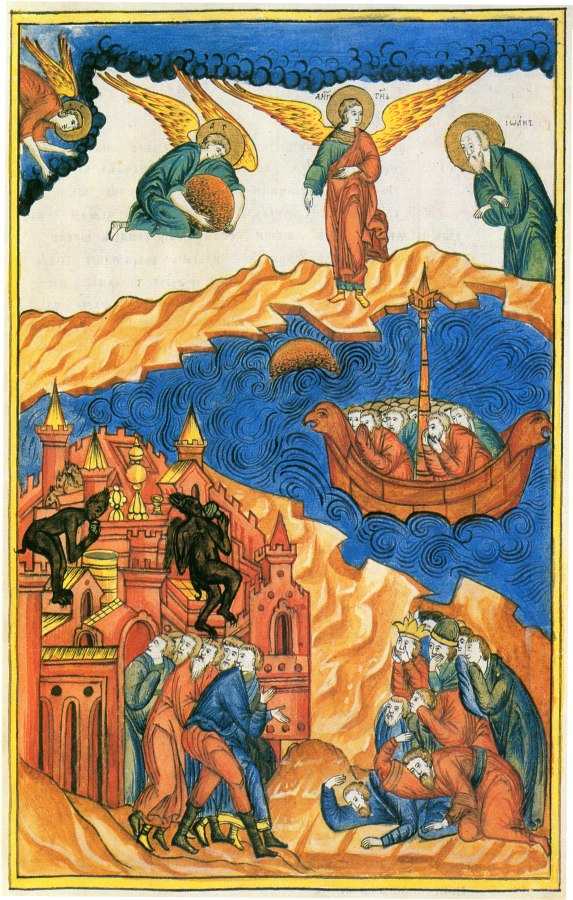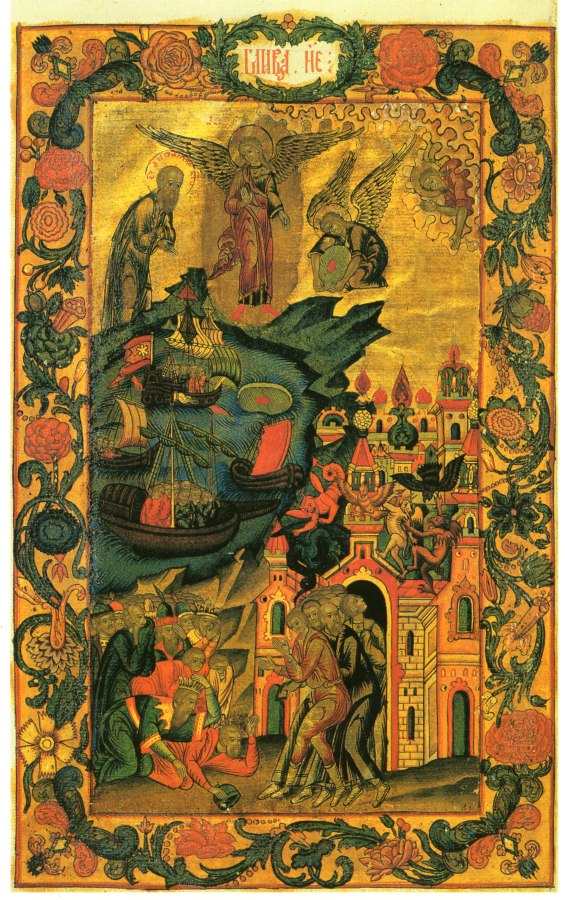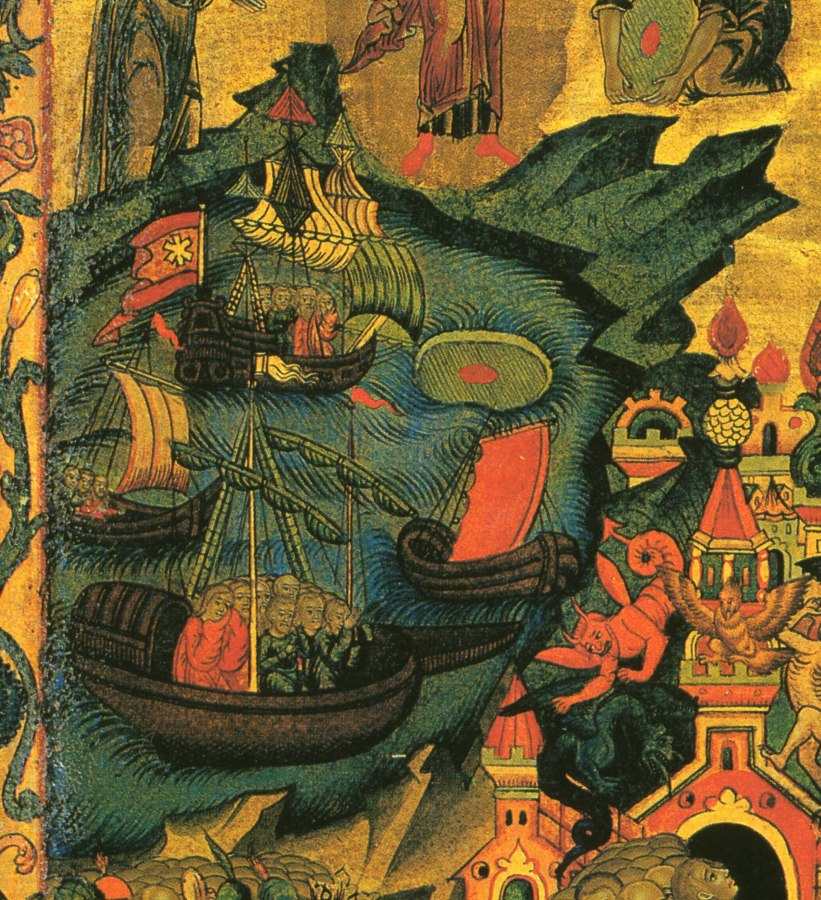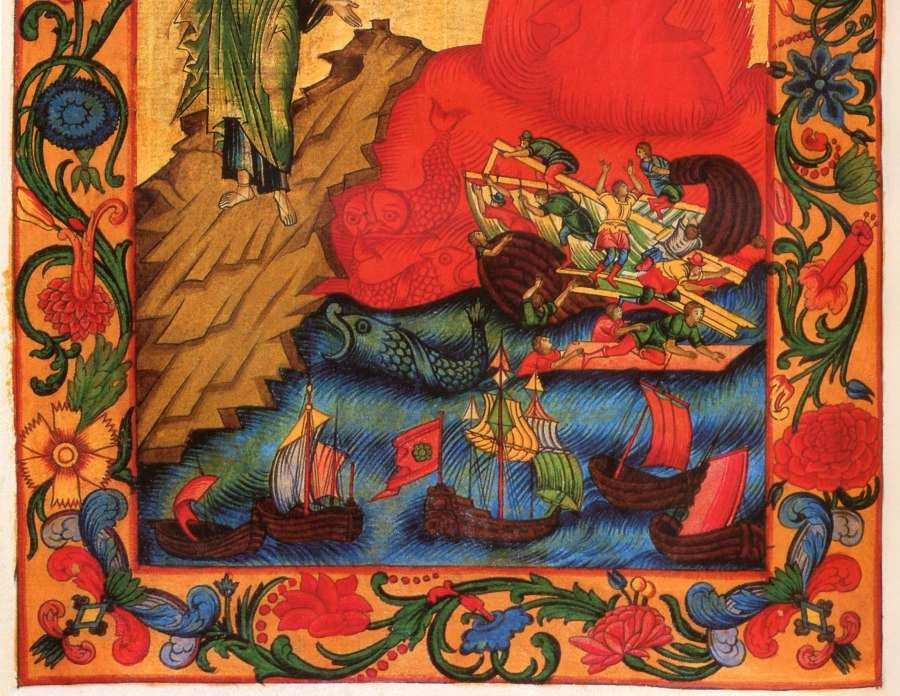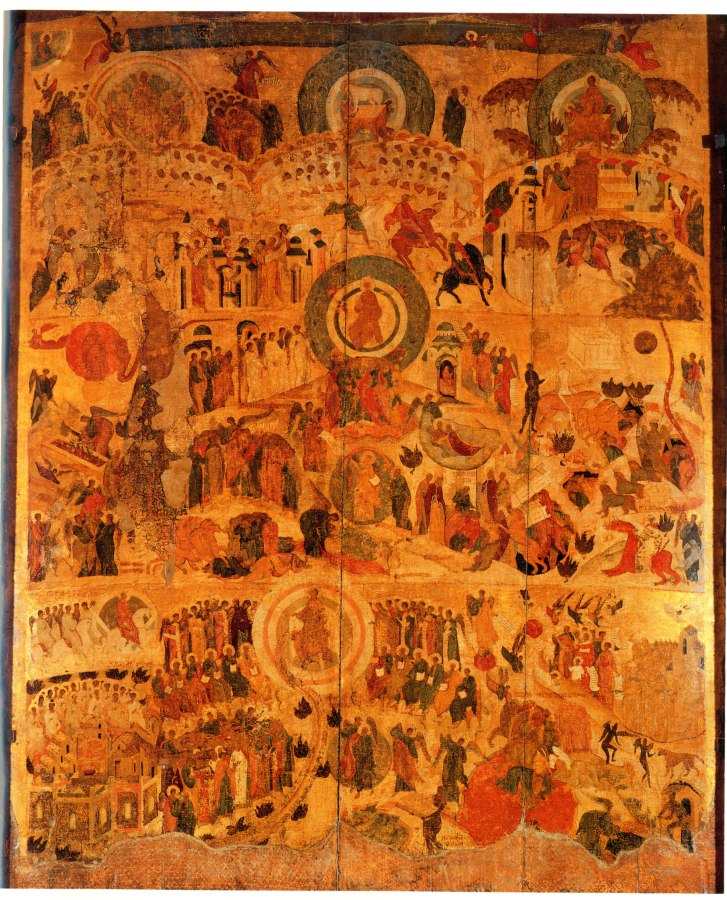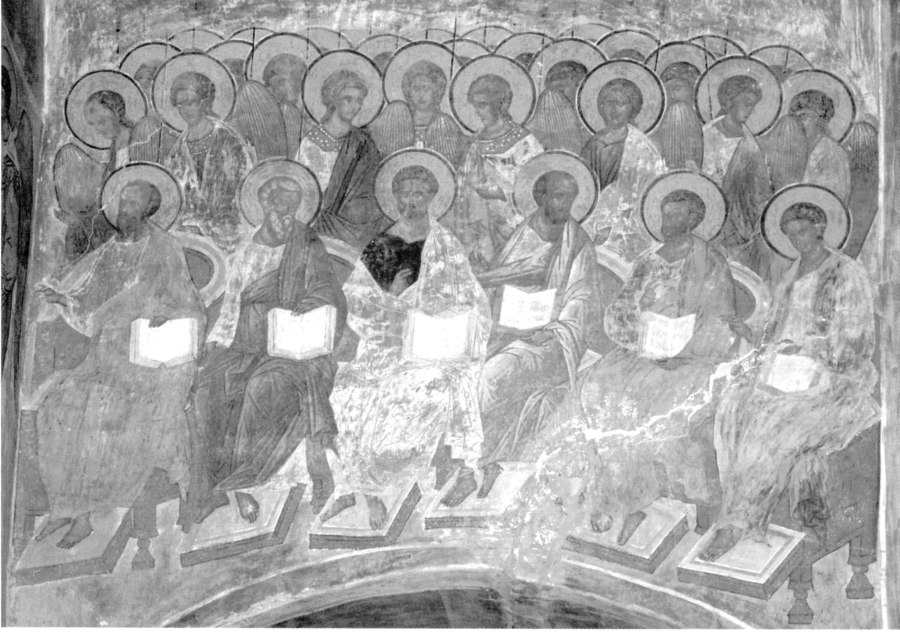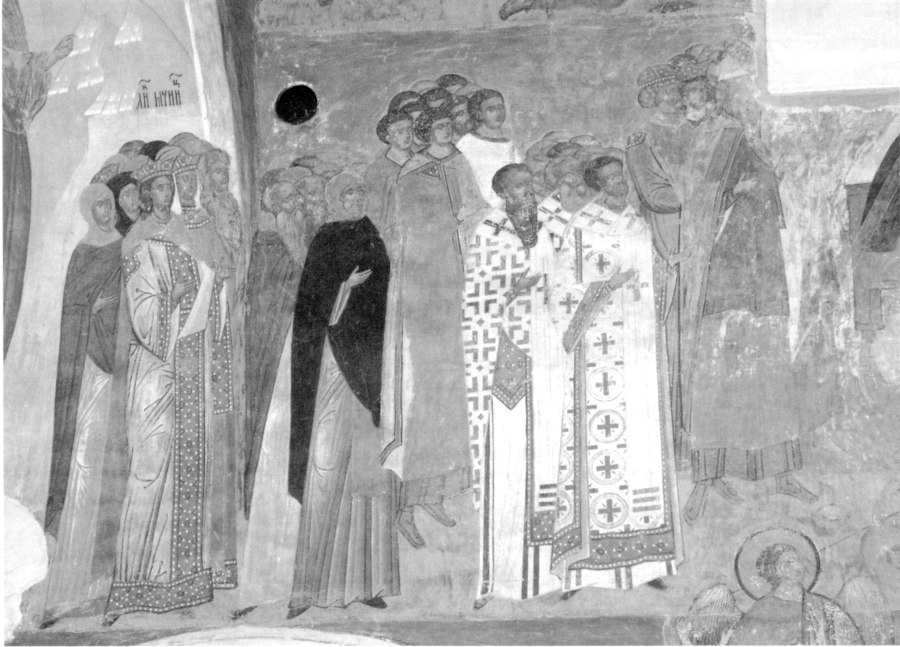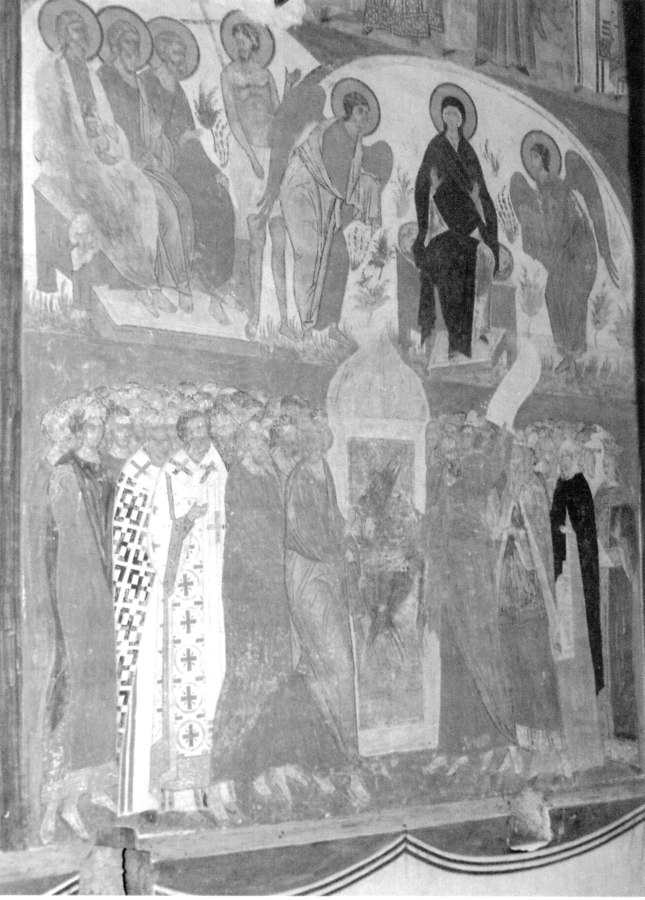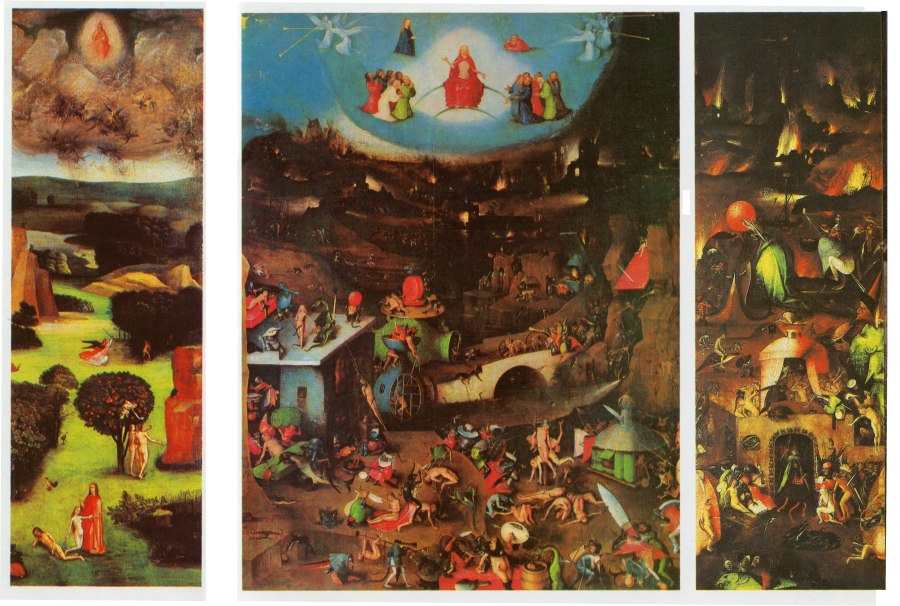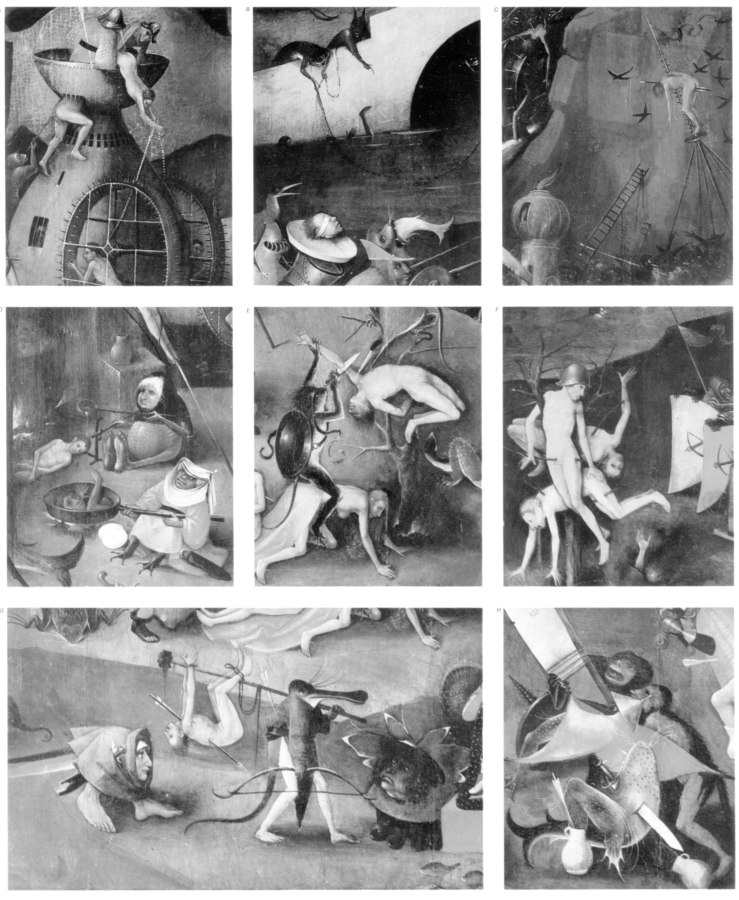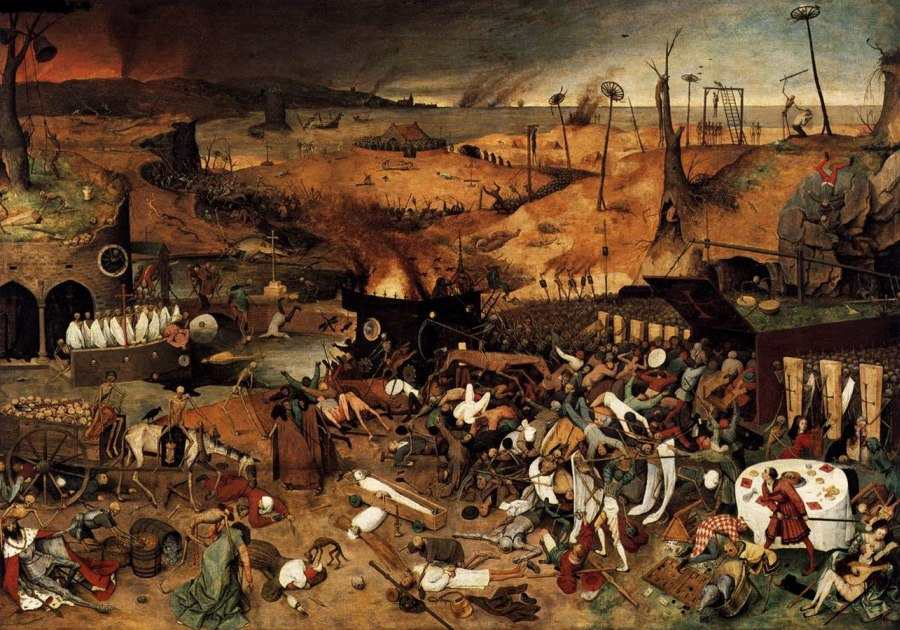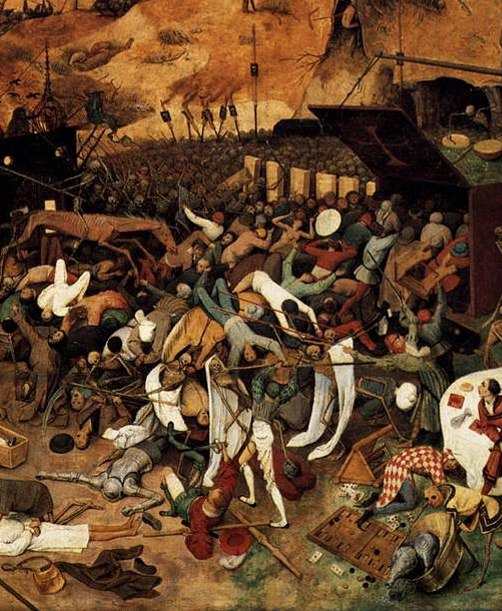ADDENDUM 2.
6. A possible reference to Noah = Columbus and his voyage towards the New World in 1492 made by the author of the Revelation.
We have identified the famous Biblical legend of the deluge and the voyage of Patriarch Noah across the “great waters” as an account of the voyage of Columbus in CHRON6, Chapter 14. It is a very important corollary of the New Chronology, and we discuss it at length in CHRON6. For the meantime, we shall merely refer to this research in order to obtain additional data pertaining to the Revelation.
There are some traces of the legend of the “deluge” and Partiarch Noah = Columbus in the Apocalypse – despite their vagueness, we shall mention them in order to ease the labour of future researchers.
The Book of Revelation contains the following lines: “And the second angel sounded, and as it were a great mountain burning with fire was cast into the sea: and the third part of the sea became blood” (Rev 8:8). Also: “And a mighty angel took up a stone like a great millstone, and cast it into the sea” (Rev 18:21). Furthermore: “And the temple of God was opened in heaven, and there was seen in his temple the ark of his testament” (Rev 11:19).
It isn’t to be ruled out that the report of a great mountain or “millstone” falling into the sea was an attempt to describe a huge wave that drowned a part of the world made by the author of the Revelation – the “deluge”, in other words. Moreover, the Biblical legend about Noah’s journey across the “great waters” tells us about the rainbow that appeared in the sky by the will of God as “the eternal testament” when Noah reached dry land (Genesis 9:16). The repercussions of these events may have ended up in the Book of Revelation.
This brings us to the year 1492, when the fleet of Columbus = Noah sailed forth into the Atlantic, and the Horde commenced the conquest of the Americas (New World) together with the Ottomans (see CHRON6, Chapter 14). Therefore, all three dates (1453, the fall of Constantinople = Babylon, 1486, the date ciphered in the Book of Revelation, and 1492, the year Columbus = Noah set sail for the American continent) fall over the end of the XV century, or the beginning of the Ottoman = Ataman conquest of the Promised Land.
There was a remarkable mediaeval tradition of illustrating the Apocalypse with pictures of some lengthy maritime voyage. Some such miniatures are reproduced in figs. d2.17, d2.18 and d2.19. It has to be noted that the miniatures in figs. d2.18 and d2.19 are both entitled as follows: “The Lord’s people leaving Babylon. The Angel throws a millstone-like rock into the sea”. And we must keep in mind that some ancient chronicles did in fact regard the expedition of Columbus = Noah as the very exodus of the Israelites = Theomachists from the Old World to the New World, qv in CHRON6, Chapter 14. The six-pointed star (known as the Star of David today) must have been placed on the flag of one of the ships for a good reason (fig. d2.20). Let us remind the reader that the symbol in question happens to be one of the ancient versions of the Christian cross, which was declared exclusively Judaic in the XVII-XVIII century and used by the Orthodox Church no longer. Another miniature from the Book of Revelation that depicts a sailing fleet on the sea is reproduced in fig. d2.21.
This might explain the following passage from the Book of Revelation: “And I saw a new heaven and a new earth: for the first heaven and the first earth were passed away, and there was no more sea” (Rev 21:1). This might well be a reference to the New World, or America, which was reached by the troops of Russia, or the Horde = Israel when they crossed the ocean (“and there was no more sea”), leaving the Old World behind.
It is rather curious that the Old Testament Book of Genesis appears to contain vivid repercussions of the motifs familiar to us from the New Testament Book of Revelation.
The fact that the Biblical story of Patriarch Noah is but another reflection of the events of 1492 A. D. is also confirmed by the following circumstance: the Book of Genesis directly associates the voyage of Noah with the demise of humanity – a cataclysm that presumably destroyed nearly all of the Earth’s population. Therefore, the “doomsday” of 1492 is described in the Bible as the Great Deluge. One must point out that the Bible interprets the Deluge as a punishment for human “wickedness” sent by God himself, thus being perfectly unanimous with the Revelation: “The sons of God came in unto the daughters of men, and they bare children to them . . . And God saw that the wickedness of man was great in the earth . . . And it repented the Lord that he had made man on the earth, and it grieved him at his heart. And the Lord said, I will destroy man whom I have created from the face of the earth . . . The earth also was corrupt before God, and the earth was filled with violence . . . And God said unto Noah, The end of all flesh is come before me; for the earth is filled with violence through them; and, behold, I will destroy them with the earth” (Gen 6:4-7, 6:11 and 6:13).
The events that follow are completely identical to those described in the Book of Revelation. God divides humanity into the righteous and the wicked; the former are saved from the cataclysm, and the latter perish in the deluge, so the Book of Genesis contains another account of the Judgement Day as described in the Revelation. The New Testament Jesus Christ became reflected in the Genesis as the Old Testament God who sent the deluge as a punishment to humankind. The righteous begin a new life on a new land in either case.
Also, the Revelation keeps telling us about the fall of Babylon. Similarly, the Genesis reports the destruction of Babylon and the Tower of Babel just as the story of Noah ends (Genesis 11:1-9). “So the Lord scattered them abroad from thence upon the face of the earth: and they left off to build the city. Therefore is the name of it called Babel” (Genesis 11:8-9).
It would be apropos to emphasise that the whole text of the Bible contains just two descriptions of a “global cataclysm” – the Great Deluge followed by the destruction of the Tower of Babel and the Judgement Day as described in the Book of Revelation. As we see, these two unique descriptions of world demise turn out to reflect the same crucial mediaeval events of the late XV – early XVI century. Thus, a careful study reveals the two motifs to be more or less identical, although the two descriptions must have been written by different Biblical authors.
And so, the legend of Patriarch Noah, the Deluge and the Tower of Babel as contained in the Old Testament must be yet another literary version of a key New Testament motif, albeit related more briefly than in the Revelation.
7. Expectations of Doomsday in 1492 coincided with the departure of Noah’s (Columbus’s) fleet and the epoch of the Biblical Apocalypse.
The fleet of Columbus set forth to conquer the Americas in 1492, the very year that the “end of the world” was expected to take place (see CHRON6, Chapter 14 for more detail). Since the Revelation describes the Judgement Day (a global cataclysm resulting in the death of the Old World and a new life in New Jerusalem, or the New World, the three seminal historical events of the epoch turn out to be in close chronological proximity, namely:
1) The departure of Columbus = Noah in 1492.
2) “Doomsday” in 1492.
3) The creation of the Book of Revelation – in 1486 the earliest.
Interestingly enough, the history of the Revelation in its Scaligerian version presumes that the Book of Revelation remained “in the shadows” between the alleged I-II and XV century A. D., without attracting much attention ([623], pages 8-10). However, right at the end of the XV century the Revelation becomes the focal point of everyone’s attention, greatly influencing the life of the XV-XVI century society. This absurdity disappears in our reconstruction – the “Dark Ages” never existed; the Revelation was written at the end of the XV century, in 1486 the earliest, as the record of the second conquest of the world by the Ottomans = Atamans (which followed the Great = “Mongolian” conquest of the XIV century).
This is what we learn from the historians: “A new surge of interest in the Book of Revelation and its author falls over the end of the XV century A. D., due to the approach of the seventh millennium. Doomsday expectations led to numerous disputes amongst the Westerners and the Orthodox Christians. A series of related oeuvres is written in Moscow around 1492 [sic! – Auth.]; visual arts didn’t remain unaffected, either – the grandiose ‘Apocalypse’ icon dates from the same period (it is kept in the Ouspenskiy Cathedral of the Muscovite Kremlin . . . For the Western Europe, the end of the XV century was marked by the creation of 15 apocalyptic engravings by Albrecht Dürer in 1498 [two years later than the date contained in the astronomical horoscope of the Revelation, which is 1486 – Auth.]. A new edition was made in 1511 and proved extremely influential, likewise the Apocalypse of Luther illustrated by artists of no lesser renown . . . The apocalyptic imagery was used in the XVI century and even later for embroideries, a series of Brussels carpets etc.
The XVI century was to some extent perceived as apocalyptic in the Eastern Christian world as well . . . Doomsday motifs became the most popular among the illustrators of manuscripts.
However, apocalyptic scenarios lost their appeal for both the Westerners and the Russians in the epochs to follow” ([623], pages 10-11).
Nothing to wonder about. The Book of Revelation became a crucial part of the Bible immediately after its creation – in the late XV – early XVI century, since it was the account of the Ottoman = Ataman conquest. It remained an extremely important work for the whole duration of the Promised Land’s conquest in the XV-XVI century, and also during the epoch of the Great Strife and Reformation – the XVII century, that is, when the memory of the conquest was still alive. However, by the XVIII century the events described in the Book of Revelation have faded into the past, and the emphasis was shifted elsewhere. The Apocalypse took its place at the end of the New Testament as an important book telling us about the Judgement of Jesus.
Let us once again consider the “Doomsday” as expected in 1492. The consensual version of history claims that its date was calculated in advance as the 7000th year since Genesis, which fell over 1492 A. D. However, our hypothesis suggests another explanation.
The Ottoman = Ataman conquest started at the end of the XV century, and had nothing to do with the calculated date of the Apocalypse, as we have already stated. In 1492 the wave of the conquest reached the Atlantic coast of Europe. The first version of the Revelation was written in the epoch of 1486-1492; it dealt with the conquest of the world by the Ottomans = Atamans. Having conquered Europe, which later became known as the Old World, Russia, or the Horde, and the Ottoman = Ataman Empire joined forces for the conquest of America. The military fleet of the Horde (Noah = Columbus) set forth across the ocean, carrying thousands of colonists from the Horde (or Theomachist Israelites). The New World, or America, was discovered and colonised as a result. Many areas of the Western Europe still lay in smoke-covered ruins after the “quarantine campaign” of the Ottomans and their relentless persecution of the Bacchic cult, which the Book of Revelation called “Babylonian fornication”.
The sum total of these events may well have produced the magnificent and terrifying image of God’s Judgement in the minds of people as the end of the Old World and the dawn of the New World, or the foundation of New Jerusalem. The apocalyptic terminology may date from this very period, being a reaction of the Western European populace to the great and horrifying events of the late XV century.
Later chronologists of the XVII-XVIII century, who were creating or adjusting the global chronological systems, the theory of different eras etc, may have combined the bygone end of the XV century with the round calendar date of seven thousand years calculated in retrospect in order to develop a theory, according to which the very round nature of the date was catastrophic, the implication being that the end of the world was expected to come in 1492.
However, we must once again emphasise that all of these theories and calculations date from a later period, when everyone has already forgotten that the apocalypse wasn’t expected as a predicted event at the end of the XV century, but rather took place as a real event – the Ottoman = Ataman conquest and the merciless “surgery” performed on many European countries. It is for this very reason that the scenes of divine judgement contained in the Book of Revelation shook the people to the very bone. It wasn’t a “prophecy” of any kind, but rather a report of recent events, which were real and thus truly horrifying. It is therefore highly unlikely that the Czars, or Khans of the Empire watched the calendar in order to make their “quarantine campaign” coincide with the round date of seven thousand years. In other words, it doesn’t seem plausible that contagious diseases waited for this date to spread across Europe. It appears more rational to assume that the year 1492 was declared equivalent to the year 7000 “since Genesis” in retrospect. However, we by no means insist on this particular reconstruction of calendar system history. This issue requires additional analysis.
Our hypothesis can therefore be encapsulated as follows: the “end of the world” did in fact take place in the Western Europe and was described in the Book of Revelation in the most impressive manner. However, this event was later erased from the history of the XV-XVI century and transferred into the future. The existing Book of Revelation was rewritten and declared a prophecy of future events after the destruction of the original text. Why was it done? Let us linger on it for a while.
8. The canonization of the Book of Revelation as a memento of the Ottoman = Ataman conquest for future generations.
In CHRON6, Chapter 5:4, we demonstrate that the Ottoman = Ataman conquest became reflected in the history of Europe as the conquest of St. Jacob. Furthermore, we have pointed out that the famous map of St. Jacob’s “religious conquests”, which was most likely the map of the Ottoman = Ataman European campaigns of the XV-XVI century was canonised and declared a holy collection of pilgrimage paths that needed to be walked by everyone every year in order to worship the holy relics of St. Jacob in the Spanish cathedral of Santiago de la Compostela. This is how the Church attempted to preserve the memory of the Ottoman = Ataman conquest for centuries to come.
A similar fate befell the Book of Revelation, or the book of the Ottoman conquest. It was canonised, declared holy and made an object of worship for all the generations that followed the XVI century.
As we have already mentioned, the Book of Revelation was trusted by great masses of Europeans and influenced them greatly for the simple reason that it described real events that horrified everyone – the epidemics as well as the fierce and radical cure. Therefore, when the book was declared a prophecy of Doomsday, everybody trusted it – after all, everyone still remembered a similar cataclysm. And so, when the Czars, or Khans of the Empire demanded compliance with their laws on the pain of divine judgement, nobody had a shadow of a doubt about the reality of the possible punishment. The memory of “the judgement of Jesus” was still very much alive. It is obvious that no abstract threat or theoretical description of a possible punishment would affect the masses quite as deeply as one backed by real events of the recent past – the epidemics and the Ottoman “amputation treatment” that followed. Abstract threats are hardly ever effective – fear is the only foundation that a functioning Imperial state could be built upon.
This is why all the churches of the “Mongolian” Empire were decorated by frescoes depicting the judgement of Jesus in a very impressive fashion. Although the judgement was declared a thing of the future, the believers must have retained the memory of such a judgement, vague as it may have been – after all, their parents and grandparents must have told them something, shuddering at the very mention of divine retribution. The rulers of the Empire effectively used the situation to their advantage as an ideological basis for making the masses comply with the imperial laws.
We must also pay attention to a most remarkable circumstance that becomes a perfectly obvious fact in our reconstruction. There was a substantial difference in how the Occidental and the Orthodox ecclesiastical tradition describes the Judgement of Jesus.
In brief, the Russians depicted the divine judgement in calm and solemn tones, without any elements of threat. The main accent was made on pictures of the righteous singing hosanna to the celestial throne. Visual representations of inferno were de-emphasised, and it was hardly regarded as a gruesome reality.
On the contrary, the Western European tradition used extremely lugubrious methods that had a great psychological effect. It suffices to recollect the works of Pieter Breugel, Hieronymus Bosch and other artists, secular as well as ecclesiastical – executions, pains of hell, torments and repulsive physiological details.
This circumstance was noticed by specialists in ecclesiastical history a long time ago: “Expectations of the Apocalypse in Russia were different from the intimation of an imminent global cataclysm typical for the West around 1000 or 1500. Orthodox eschatology was coloured in solemn and enlightened hues, the present and the future, as well as heaven and earth, were perceived as one” ([577:1], page 5). Also: “The expectations of doomsday and the second coming became reflected in the ‘Apocalypse’ – the oldest Russian icon known to us that depicts these events. The main motif, which is repeated in the icon several times, is the hosts of the righteous clad in white that sing hosanna to the throne of Lord” ([577:1], pages 11-12).
Everything is crystal clear. No “quarantine actions” were ever carried out on the actual territory of Russia or in the lands of the Ottomans. Therefore, the attitude to Doomsday was a great deal more relaxed. There were other troubles, just like anywhere else, but the gruesome “surgical operations” did not affect Russia or the Ottomans.
On the other hand, the Western Europe was the target of the Ottoman invasion, with punitive measures carried out in full. We can reconstruct the atmosphere that prevailed in Europe in the XV-XVI century from the books of Exodus and Joshua. Therefore, the population, which was saved from the epidemics by the most drastic measures imaginable, considered Doomsday a reality, something that had already happened in the past. Hence the horrifying motifs in the paintings and the frescoes of numerous Western artists – they resulted from the recent memory of a great cataclysm.
Let us reproduce the solemn and enlightened eschatological artwork typical for Russia to illustrate the above – the “Apocalypse” icon (artist unknown) painted around the end of the XV century and fragments of the “Doomsday” fresco by Dionysius (figs. d.22, d2.23, d2.24 and d2.25). Now let us compare them to the sinister paintings of Hieronymus Bosch (figs. d2.26 and d2.27) and Pieter Breugel (fig. d2.28 and d2.29) typical for the Occidental tradition of eschatological motifs in art.
Another crucial detail is the difference between the Occidental and the Orthodox attitude to the Book of Revelation. Apparently, “the tradition of the Orthodox Church . . . has no recollection of its text ever used during religious services, whereas the Occidental Church issued edicts to make its readings mandatory as early as in the V or VI century A. D. [the XV-XVI century, according to the New Chronology – Auth.]; the Book of Revelation was to be read between the holy feasts of Easter and Pentecost” ([623], page 13). Moreover, the canon of the Orthodox Church “forbids reading it during religious services” ([623], page 5).
Once again, everything is perfectly obvious. The reading of the Book of Revelation was made the responsibility of the Occidental priests (in the XVI-XVII century, at least) so that the Westerners wouldn’t forget the Judgement of Jesus that befell the Western Europe in the XV-XVI century. Bear in mind that the Imperial “quarantine action” had the Western Europe as its target – the Ottoman = Ataman troops separated the “clean” from the “unclean” – the healthy from the infected, in other words. The memories of Doomsday was to be kept alive in order to prevent the masses from returning to the attractive Bacchic cults that had once resulted in epidemics. As for the east of the Empire, the atmosphere that reigned there was completely different. Orthodox Christianity was ascetic ever since the XII century; there was nothing remotely resembling the “ancient” Bacchanals. The same is true about such late branches of Christianity as Islam. Therefore, there was no need to read the Book of Revelation in the Eastern churches.
Apparently, the shock suffered by the Western Europe in the XV-XVI century as a result of the Ottoman = Ataman conquest invoked a deep hatred for the “surgeons”, which did not previously exist. The fact that the “surgery” actually cured the “bacchic infection” was conveniently forgotten. The emphasis was made on the bitter feelings left by the “mandatory cure” – the Western European reformists that yearned power may have used it for ideological purposes later on, their primary goal being the fragmentation of the Empire. This facilitated the organization of a coup d’état inside the Empire and eventually led to its fall.
The bitter feelings of the Westerners are a perfectly natural phenomenon. However, we must reiterate that the quarantine operations were sanctioned by the Czars, or the Khans of the Empire in order to stop the epidemics and not due to some pathological maliciousness of the Imperial rulers. Unfortunately, the medical science (as well as science in general) wasn’t sufficiently evolved in that epoch, which made it impossible to solve the problem by more humane means. Being unable to stop the population of the Western Europe from dying en masse by means of inoculations and medicines, the Khans decided to combat the plague with fire and red-hot iron. They did what their common sense suggested in order to save Europe and the Empire in general – this is precisely what the Bible says. However, any surgical operation conducted without anaesthetics and accompanied by bleeding will make the patient scream out in pain, and the memory of this event is unlikely to go away easily.
In the XVII century the Reformist Western Europe became independent at last, qv in CHRON6, Chapter 9. The divide of the Great = “Mongolian” Empire gave the West Europeans an opportunity to invade Russia and destroy the regnant dynasty physically. The throne was seized by the pro-Western Romanovs, who launched a campaign of terror and persecutions that engulfed the whole of Russia, introduced serfdom (which translates as the enslavement of the majority of its population). The occupational Romanovian regime remained regnant for a long time, resulting in the eradication of the old “Mongolian” traditions on the whole territory of Russia that they controlled and drastic changes in every aspect of the country’s life, including the ecclesiastical.
It is little wonder that in the epoch of the Great Strife the Russians may have interpreted the Book of Revelation as a prophecy of the imminent Doomsday – this time in the East. Our reconstruction is confirmed well enough by the history of the XVII century. Let us quote: “A new surge of interest in the Book of Revelation falls over the middle of the ‘rebellious’ XVII century in Russia . . . The adherents of the old traditions saw the relentless reformist [Patriarch Nikon – Auth.] as the Antichrist himself – or at least his precursor . . . Doomsday was expected to come in 1658 . . . then in 1666, and finally in 1699 (similarly to the situation of 1492, with the earthly term of Christ’s life taken in consideration).
The state reforms of Peter started shortly afterwards, as if to confirm the expectations . . . Starting with the middle of the XVII century and for the 150 years that followed, the Book of Revelation becomes all but the main book of the Russian old-believers . . . Apocalyptic vision was especially characteristic for the extreme factions of the old-believers that recognized no priest authority, such as the ‘vagabonds’ (also known as the ‘fugitives’), who denied the possibility of salvation within society, which they shunned, believing the kingdom of Antichrist to be a reality and not merely a prophecy” ([623], pages 29-30).
One must also bear in mind that the Romanovs distorted the history of Patriarch Nikon’s reforms to a great extent (see CHRON4, Chapter 9:4, and CHRON6, Chapter 10:11, and CHRON6, Chapter 13:2). Therefore, his role requires a new assessment, as well as the events of Peter’s epoch in general.
In CHRON6, Chapter 9:14, we demonstrate that the Napoleonic invasion of 1812 must have been the second act of revenge against the former centre of the Empire, which was striving to regain its imperial supremacy under the new generations of the Romanovs. Many strata of the Russian society perceived Napoleon’s invasion as the advent of the Antichrist. “It wasn’t just the old-believers who viewed the invasion of the Napoleon’s army into Russia through the prism of the Book of Revelation. Tolstoy’s Pierre Bezoukhov was obsessed with unravelling the mystery of the number 666 . . . His anonymous contemporary, an old-believer of the first quarter of the XIX century . . . wrote the ‘Tale of Napoleon the Antichrist’ somewhat later – a late Russian eschatological oeuvre where the Biblical images are bizarrely entwined with the historical characters of the early XIX century” ([623], page 30). The Judgement Day thus became a reality for many people of the XVIII-XIX century, and a Russian reality at that.
“It is therefore hardly surprising that hundreds of copies of the Apocalypse were made [in Russia – Auth.] in the second half of the XVII century and the beginning of the XIX” ([623], pages 29-30).
9. MOSCOW EVENTS OF THE XVI CENTURY ON THE PAGES OF APOCALYPSE.
In the Apocalypse, it is said about the bad "wife of Jezebel." In particular: "I have something against you, because you let your wife Jezebel, calling herself a prophetess, to teach and mislead My servants, to commit fornication and to eat idolatrous sacrifice. I gave her time to repent, but she did not repent. I will throw her and her fornicators on a deathbed and put them to a great sorrow ... And I will kill her children with death"(Apost.2: 20-21).
According to the dynastic parallelisms discovered by us (and described
in the book "Foundations of History", Ch. 6, Fig. 6.29, Fig. 6.30,
details in the book "Reconstruction", Chapter 13: 20), the biblical Jezebel is the Russian queen Elena Glinskaya, the wife of Basil IIIrd and the mother of the Csar Khan Ivan the Terrible. She died young, in 1538.
It is also described in the biblical book 3 of Kingdoms. Her husband, Vasily IIIrd is reflected on the pages of the Bible under the name of the famous king Ahab.
It becomes clear why the Apocalypse, when exposing Jezebel, turns
here it is to the "Thyatira Church" (Apost.2: 18) and "to the rest,
which is in Thyatira "(Ap.2: 24). Given the frequent transition of T-F (fyta) here are most likely named the Tatar Church and the country of Tataria (= Thyatira). That is Rus-Horde.
Thus, after mentioning the Israeli queen Jezebel, the Apocalypse told us about the Moscow court events of the first half of the 16th century, around 1530-1540. Moreover, people who wrote the final version of the Apocalypse knew quite well the inner life of the Moscow Khan's court, in the metropolis of the "Mongolian" Empire of the XVI century.
10. "ANTIQUE" ROMAN EMPIRE IS GREAT = "MONGOLIAN" EMPIRE OF THE XIV-XVth CENTURIES.
Here we briefly emphasize the critical identification which will be described in detail in subsequent publications. According to the dynastic parallelisms listed in the book "Foundations of History," Chapter 6, and detailed in the book "Reconstruction," Chapter 13, as the main originals of the "ancient" kingdoms have served Russ-Horde in the XIV-XVI centuries and its later ally - Osmania = Atamaniya in the XV-XVI centuries.
The Great = "Mongolian" invasion of the XIV century created a Great Empire, which stretched across Eurasia and Africa. At the same time, colonization in XIV century of vast territories - under the banner of Jesus Christ (1152-1185), that is, a crusading conquest, - was done by Russ-Horde, probably without meeting particular obstacles. The matter, among other things, is that in that epoch Western Europe, for example, was still poorly populated. See notes of the famous medieval chronicler John Malala [338], p.28; see.
"The Empire," Chapter 11: 3.3. Consequently, the growth of Western European cities began only with the entry of these territories into the Great = "Mongolian" Empire.
As we have already said in the book "The New Chronology of Russ," ch.14: 22, according to John Malala, the main "ancient" Greek gods, such as Crown, Zeus, and others - were NO GODS, but THE FIRST Assyrian CZARS. That is, as we now begin to understand - they were Russian-Horde
Kings of the XIV century. That is Ivan Kalita = Caliph, George Danilovich, and their successors.
Dynastic parallels unambiguously show that the "ancient" Roman Empire is the Great = "Mongolian" Empire of the XIV-XV centuries. That is, from its appearance up to the Ottoman = Ataman invasion of late XV-XVI centuries. In other words, "ancient Rome" is a reflection of the history of the Russ-Horde of the fourteenth and fifteenth centuries on the pages of "antique" books, written, mainly in Western Europe, in the XV-XVII centuries. This is the true story of "Mongolia," but refracted through the prism of somewhat one-sided perception of reality that has developed in the minds of a specific emerging layer of Western Europeans of the Reformation.
Let us repeat that this important fact of our reconstruction follows from chains of dynastic parallelisms discovered by us earlier and given in the book "Foundations of History," Chapter 6.
Namely, the following "ancient" Empires were identified:
1) The Second Roman Empire supposedly I-III centuries, that is, "ancient Rome,"
2) The Third Roman Empire allegedly III-VI centuries, that is, "ancient-medieval Rome,"
3) The Holy Roman Empire allegedly X-XIII centuries.
4) The Empire of the Habsburgs of the fourteenth and sixteenth centuries.
5) Russian-Horde Kings-Khans of the fourteenth and sixteenth centuries.
We did not focus the reader's attention on the final Identification 1) = 5), since it was considered necessary to prepare the psychological soil, describe at first less radical parallels,
identifying with each other "ancient" dynasties with "very ancient," for example, 1) = 2). And only then go to the main identifications, giving the final picture.
The direct parallelism of events and biographies, that is, without intermediate chains, combining Kings-Khans-Emperors of the Horde with "antique" Roman Emperors, we will present in further publications.
In the XV-XVI centuries, extensive Western European and African-Egyptian territories of the Great = "Mongolian" Empire were shattered by the Ottoman = Ataman invasion, which spilled over and overwhelmed America. In the memory of Western Europeans of the XVI-XVII centuries, descendants of first waves the Horde in the XIV century, the times of the "ancient" Rus-Horde XIV-XV centuries turned into a beautiful nostalgic memory. About this past of Horde
Western Europeans began to speak and write in the 16th-18th centuries as
about the "beautiful majestic ancient Rome," that perished under the blows of the "bad people." Having distorted history, they began to forget that the invasion of Ottomans = Atamans was needed, first of all, to stop epidemics in Europe. The "reformers" put forward a military aspect of the invasion. The blame for the "barbarous rout of ancient Rome" (that is, western provinces of the Russ-Horde of the fourteenth and fifteenth centuries) was assigned to "aggressors" Russ-Horde and Osmany = Atamany Empire of the XVI-XVIIth centuries. Consequently, the tension was born between the West and the East, which in the XVIII-XIX centuries led to a military confrontation, and then even provoked a war between Russia and Western Europe.
Now it becomes clear why Western Europeans, starting with XVI-XVIIIth centuries began to treat "iron ancient Rome" with such reverence and trepidation, They began to talk about it with the elements of idealization, presented as a beautiful and harsh legend, worthy of imitation. In the XVII-XX centuries throughout Western Europe respectfully repaired, and restored the "ancient" Roman ruins. And there, where almost nothing has been saved, simply re-created them, declaring the remnants to be Roman military camps, aqueducts, theaters, arches, etc. Because they really wanted to have their own "ancient" sightseeing sites. "That is, they quite frankly" portrayed" Roman antiquities. Not embarrassed at all, they erected, say, several half-ruined columns with remains of arches made from today's modern reinforced concrete. Europeans tried to make cracks and holes carefully ("from barbarian bombs") in newly-made walls. Competently and beautifully broke off new bricks. They covered the top with mud and slut. To be "as in antiquity."
Moreover, nearby, picturesquely put a few really old fragments of columns of the XIV-XVII centuries (on each - the obligatory plate: IIth century BC, VIIIth century BC. etc.). Throngs of tourists visit the antiquities, for example, the "ancient Roman" military camp in the northern part of the German city of Xanten, the land of Nordrhein-Westfalen, which we had a chance to visit in 1993 and to examine in detail all the "sights." It is so called in the guidebooks - "reconstructed camp." As it were, the theatrical scenery, the performance on the ground.
Important elementary education of "the correct Western European history."
The famous French artist Hubert (Hubert) Robert (Robert, 1733-1808) in 1784 was appointed responsible for the organization of the Louvre museum and the keeper of its art gallery [493: 1], p.17, 574. He created a whole series of huge and magnificent, impressive paintings, glorifying the ruins of "ancient Rome." Robert was named a new hope of French art" [493: 1], p.574.
He painted giant, dilapidated Roman temples, illuminated by the setting sun. Monstrous fragments of statues, highlighted by the mysterious moonlight.
Hypertrophied colonnades, overgrown with trees ...
And the ancient buildings of such incredible sizes that, in fact, never were existed in Western Europe. Huber Rober simply strove for such exaggerations to excite the emotions of viewers. As we start to understand now, he was the spokesman of a certain spirit of his time. On the background of collapsed silent "antique" temples, a talented artist put small figures of people, enthusiastically looking at the traces of the Great Past of Europe. "Poetry of Roman ruins" attracted then and it still attracts so many today.
Hence, they divided (on paper) the history of the "Mongolian" Empire. One of its "halves" turned into an idealized embellished myth and became something to worship. And the other - actually it's the same! - branded as an empire of all kinds of evil.
Let us summarize this section of our reconstruction.
1) "ANTIQUE" Rome is but a reflection of the Great = "Mongolian" Empire of the XIV-XV centuries. Roman emperors are Russian-Horde kings khans.
2) ISRAEL in the XIV-XVI centuries was called (including in the Bible)
Rus-Horde with its capital in Vladimir, Yaroslavl = Veliky Novgorod, and
then in Moscow. At the same time, they emphasized, as it were, fighting for god, militarized nature of the metropolis. Everything is clear: "Mongolian" troops The Rus-Horde always trembled.
3) JUDEA in the XIV-XVI centuries was called (including in the Bible)
Osman = Ataman with the capital in Czar-Grad = evangelical Jerusalem = "antique" Troy. At the same time, they emphasized the character of the God-praising in this part of the Empire. Everything is clear: Jesus Christ (1152-1185) lived and was crucified in Czar-Grad. Then in this city, which became sacred to Christians of all the world, they began to praise God.
